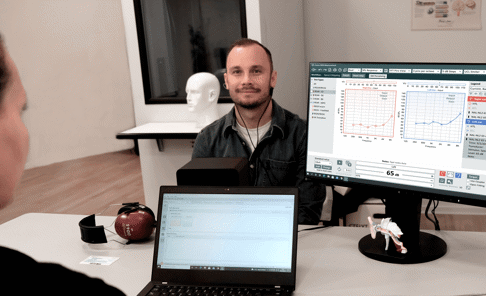
The Importance of Hearing Aid Fittings

Hearing loss can significantly impact one's quality of life, affecting communication, relationships, and overall well-being. Fortunately, advancements in hearing aid technology have provided a lifeline for those experiencing hearing difficulties. Once a hearing loss has been identified, the journey to better hearing begins with a crucial step: the hearing aid fitting process.
Understanding the importance of hearing aid fittings is essential for both hearing care professionals and their clients. A properly fitted hearing aid can make a world of difference in improving the client's ability to hear and communicate effectively.
Each patient who decides to pursue a hearing aid fitting is different in a myriad of ways, including diagnostic measures like hearing loss type and severity, as well as lifestyle differences and personal preferences. When a client arrives for their hearing aid fitting, it’s important for providers to take a personalized approach to that fit. This can be done in many ways, but two important ones include:
1. Hearing aid fit based on Real Ear Measurements (REMs)
Rear Ear Measurements are necessary and are the gold standard for appropriately fitting devices customized to the wearer. REM take into account not only the individual’s hearing thresholds, but the physical characteristics of their ear and how that affects the output of sound from the hearing aid itself.
2. Addressing Specific Needs
Each client’s lifestyle will differ, and it’s important to take that into account when fitting hearing devices. This can be in the form of special settings like speech in noise or music programs. Accessories can also be utilized to help clients in their daily lives. For example, a college student may benefit from a remote microphone, or an elderly patient may benefit from a TV streamer.
Preparing Your Patients For Their Hearing Aid Fitting Appointment

Clinicians should go over the patient’s results in detail to ensure that their patients understand their hearing test and next steps. Creating an open line of communication fosters a collaborative approach, making clients feel more empowered and involved in their hearing care journey.
Before the fitting appointment, it's crucial for clinicians to educate their patients about what to expect during the process. Share information about the duration of the appointment, the various tests involved, and the adjustments that may be made to optimize the hearing aids for individual needs. Clinicians will also likely describe the different types of hearing aids, for example, in-the-ear versus behind-the-ear, as well as the variety of hearing aid features like rechargeability, wireless connectivity, and accessories.
Setting realistic expectations for your patient helps alleviate anxiety and ensures a smoother transition to wearing hearing aids. While hearing aids offer significant benefits, it's essential to understand that they are not a cure for hearing loss. Instead, they are powerful tools designed to enhance auditory experiences. Initially, wearers may need time to adjust to the new sounds, and the improvement in hearing may vary from person to person. Hearing aids are effective in most environments, but challenging listening situations, such as noisy crowds, may still pose difficulties.
Additionally, while modern technology minimizes feedback and improves speech clarity, perfect hearing restoration is not always achievable. Realistic expectations involve acknowledging the need for periodic adjustments, regular maintenance, and ongoing communication with hearing healthcare professionals. Despite these considerations, hearing aids can substantially improve one's ability to engage in conversations, enjoy various activities, and reconnect with the sounds of daily life.
The Steps of the Hearing Aid Fitting Process
Step 1
Comprehensive Hearing Assessment
The first step involves a thorough assessment of the client's hearing abilities. This will include audiometric tests to determine the type and degree of hearing loss.
During this initial appointment, clinicians will use other measures like tympanometry, otoscopy, masking, and speech-in-noise testing to further understand a client’s hearing abilities. They will use this information to determine if a referral to an ear, nose, and throat (ENT) doctor or other professionals is necessary and if the client may benefit from hearing aids.














